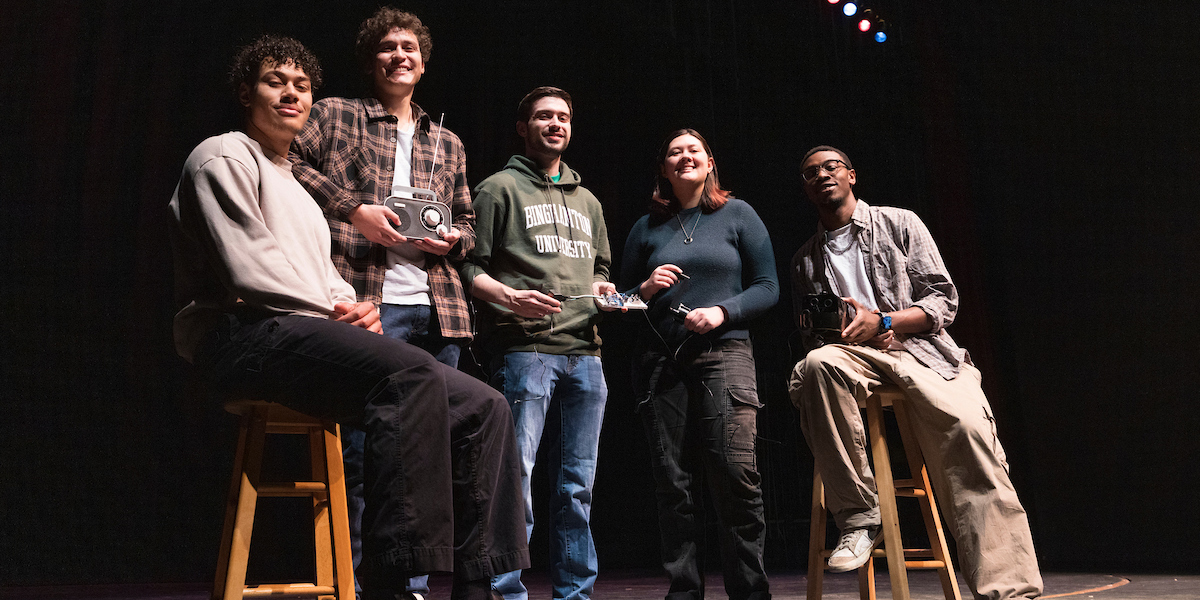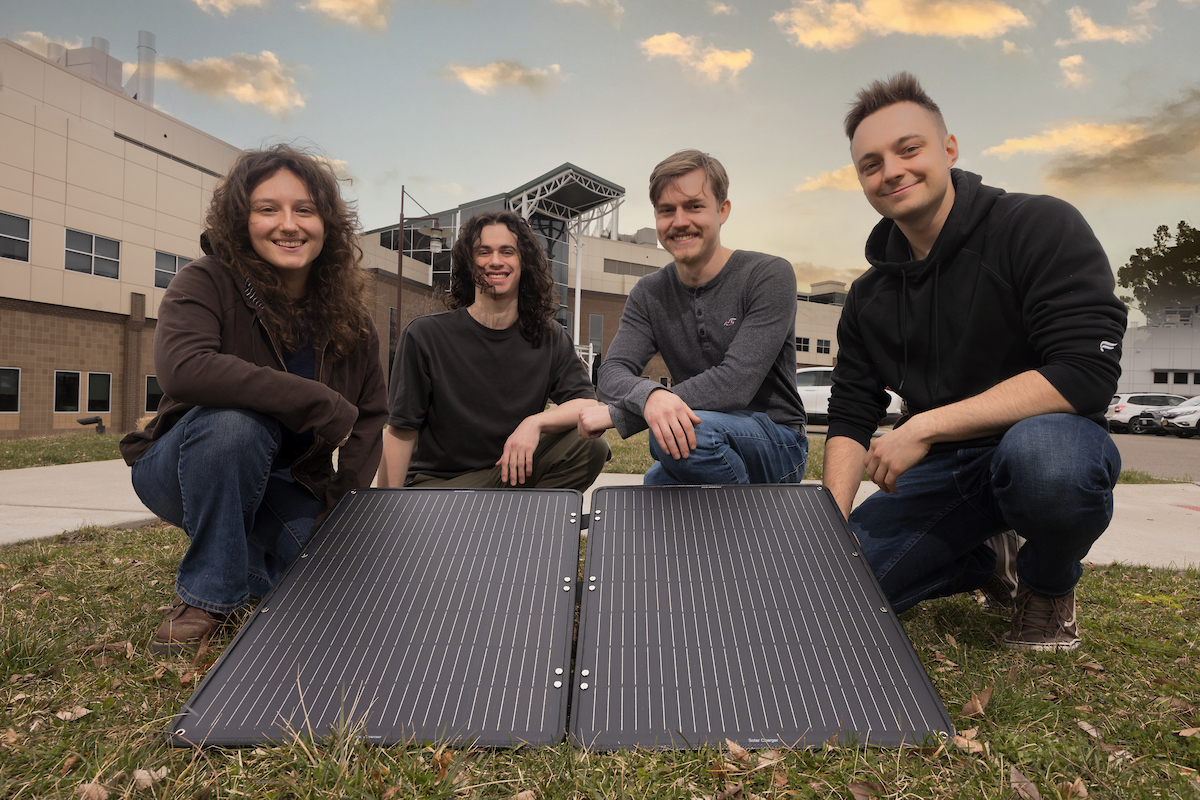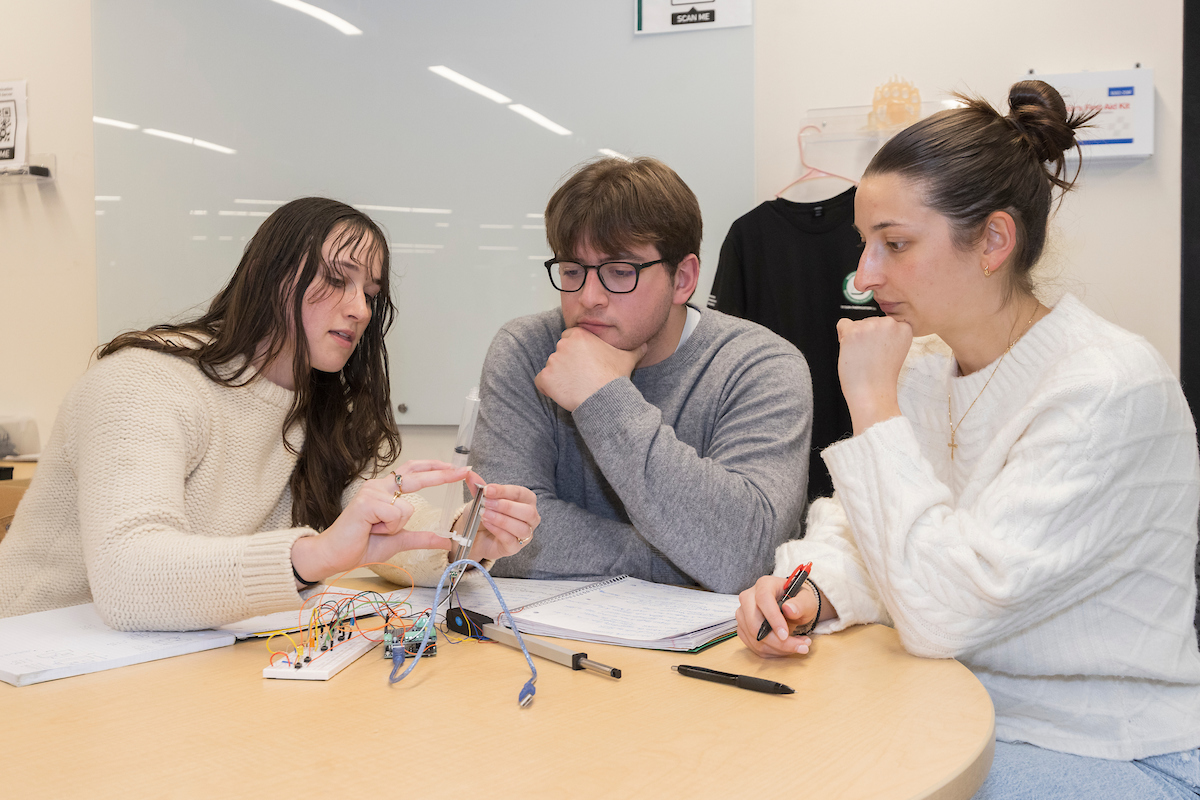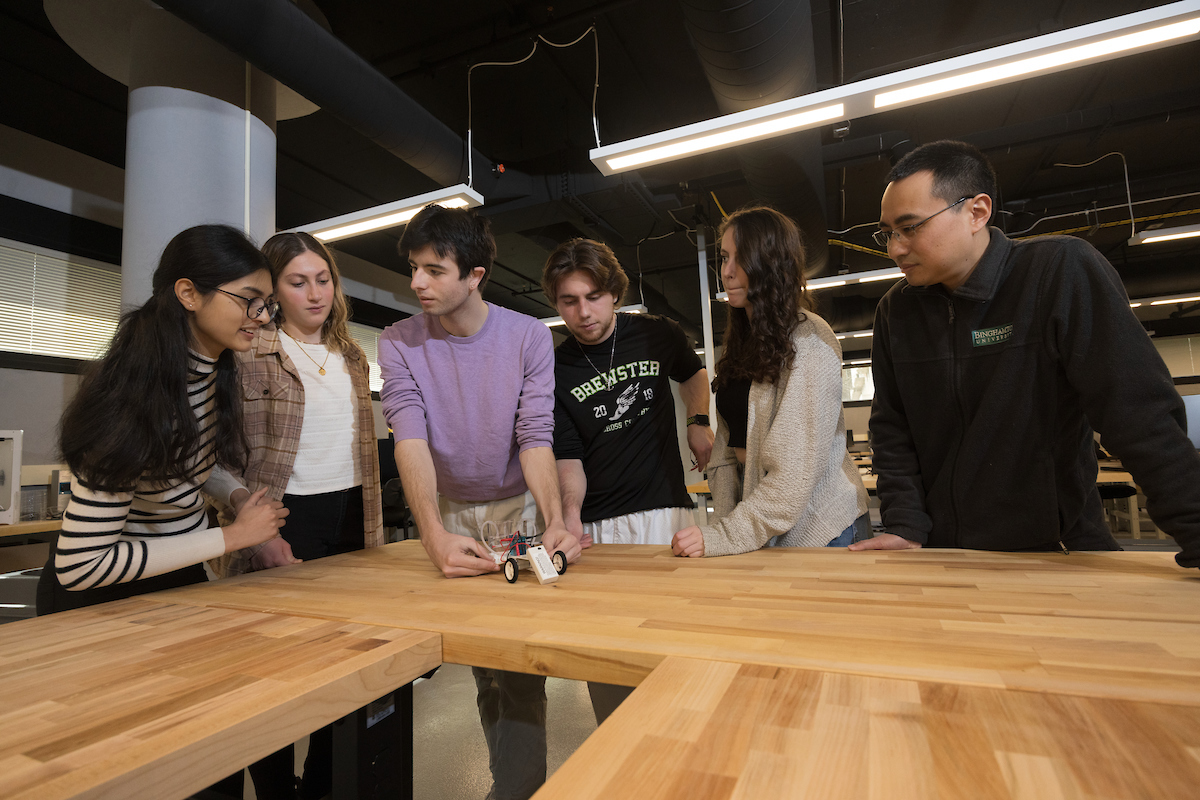Final problems to solve: Watson College capstone projects give seniors real-world experience
Here are just a few of the interesting projects from the 2023–24 academic year

Before earning diplomas, many Watson College undergraduates need to complete senior capstone projects responding to real-world challenges. Here are just a few of the interesting projects from the 2023–24 academic year, one from each Watson department (except computer science, which doesn’t have a capstone requirement).
Mechanical Engineering
Faculty advisors Associate Professor Pong-Yu “Peter” Huang and Assistant Professor Jian Zhou; students Isabelle Homan, Alexander Franciamore, Marcus Johnson, Justin Damon, Eniola Aderonmu, Coby Gottlieb
Harpur College’s Theatre Department wanted an interactive performance that would entertain children and generate interest in STEM concepts. Team leader Isabelle Homan and her fellow ME students came up with the idea of a “pedal-powered theater” operating on audience participation. “Green energy is an important topic these days, and we want to promote STEM ideas to kids from late elementary school to middle school by bringing the idea to life,” Homan says.
The system has one pedal box and two hand cranks that can either be moved around or are stationary in the audience. Once engaged, these mechanical components generate roughly 10 minutes’ worth of electricity to power small household appliances, such as LED strips, lamps and a buzzer to simulate an alarm clock.
Accessibility to the interactive components of this performance was crucial to consider, which led to the inclusion of the hand cranks and the pedal box.
“The Theatre Department wanted to have devices that were accessible for all kids, especially those who might have a disability,” Homan says. “These two devices encompass most if any possible disabilities that kids might have so they can all use them and all be able to have fun participating in the performance.”
Electrical and Computer Engineering
Faculty advisor Associate Professor Ning Zhou; AVANGRID industry advisors Joseph Yablonsky and Ryan Cuddy; students Laura Cunningham, Stephen Bauer, Ethan Hamlin, Bartosz Obszynski
Solar energy is one of the most abundant sources of energy in the world. However, this resource is unattainable for many households across the U.S. due to financial constraints.
With support from AVANGRID, this ECE team created a portable, handheld power station that can be used on the go or in the home. The device is around 2 feet by 1 foot by 1 foot and weighs under 40 pounds. It can be used almost anywhere, as long as weather conditions don’t pose a risk to the components inside. In such scenarios, the device has been fitted with a wall outlet for recharging.
It can store enough electricity to power small appliances and electronic devices and is equipped with one detachable solar panel that can be folded and carried. “Our goal is similar to existing portable solar generators for families experiencing power failures. Anyone can have it,” says Laura Cunningham, the team’s leader.
Through the development of this capstone project, the team overcame hardships and sharpened their skills.
“You have to think of everything,” Cunningham says. “Even if you don’t know what ‘everything’ is, you need to go searching on your own and figure out if there are any risks or details you missed that you weren’t even aware of.”
“Everything I’ve learned about batteries and the charge controller interested me,” Stephen Bauer adds.
Biomedical Engineering
Faculty advisors: Associate Professor Ahyeon Koh and Assistant Professor Qianbin Wang; students Alexa Varlamos, Daniel Kozersky, Gabrielle Taylor
Hospitals in the United States use more than 2 million needles per day, and preparing these syringes can cost hospitals both money and time.
Working with United Health Services in Binghamton, this biomedical engineering team designed an automated preparation system for syringes so hospitals could cut down on these expenses and boost productivity.
“Orthopedic physicians have hired personnel to follow them around all day and prepare syringes, and that is very expensive for the hospital,” Alexa Varlamos says.
To use the device, a nurse first scans a barcode for a particular drug vial, and then a linear actuator motorized system releases the desired volume of that medication into the syringe. The medications can be distributed within 30 minutes of the initial preparation.
“A doctor would say, ‘I need a shoulder injection of this many milliliters.’ Then it gets put into the system, and the device would output a fully prepared syringe,” Varlamos says.
This syringe-filling system would eliminate waiting periods in emergency rooms and greatly benefit large and small healthcare facilities.
“It has been really nice to mix my previous knowledge with open-source code and all the information you can find on the internet to tailor a solution,” Varlamos says.
Systems Science and Industrial Engineering
Faculty advisors Associate Professor Yong Wang and Assistant Professor Neha Patankar; students Nicol Haywood, Eva Greenspan, Leah Krym, Derrick Weisburd
Renewable hydrogen power holds untapped potential in the transportation sector. However, due to its high cost to generate, harnessing hydrogen power for widescale use has been a challenge.
With support from AVANGRID, the goal of this SSIE team was to create a prototype of a hydrogen fuel station that can power hydrogen fuel cell bikes.
“Our two professors want to create the first hydrogen fueling station on the East Coast,” says Nicol Haywood, the team’s leader. However, stations used to make fuel for hydrogen-powered vehicles are colossal, so “they are out of the scope of what we can do in 2024.”
Haywood and the SSIE team decided with their advisors to use one bike and one electrolyzer for their project so they could create enough power to test the bike.
Because of the electrolyzer’s size and the hydrogen-powered bike being shipped from overseas, the team had to wait a while before putting the project together for testing.
The electrolyzer generated hydrogen through the electrolysis process using water and electricity. After testing the hydrogen’s purity, the team pressurized it and filled the e-bike for testing.
“We are trying to create something that will hopefully be used by future Binghamton students, faculty and the general public,” Haywood says.



